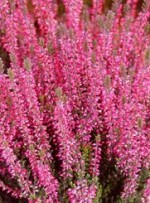 Caulluna vulgaris is the heather of literary fame associated with Scotland. It is a slow growing evergreen shrub, blooming in late summer and early fall on the moors of England, Scotland and Europe but is a good edging plant, filler in front of shrubs, or in rock gardens, with its dense clusters of bell- or urn-shaped flowers. It can also be used as a ground cover and may naturalize if it likes the site. There are hundreds of cultivars that allow for variations in flower and foliage color as well as flower fullness. Flower may be single or double and vary in color from white to pink, purple, lavender and red. The evergreen leaves are very small and scale like, and vary in color to include tones of red, purple, silver, and gold. The generic name Calluna comes from the Greek word meaning “to sweep up”, because the plant was used to garden brooms. Although the plants are generally dense and compact they may become scraggly with old age. Scotch heather is not for every garden; it demands perfect drainage and acid soil, and does not appreciate nitrogen, heat or humidity.
Caulluna vulgaris is the heather of literary fame associated with Scotland. It is a slow growing evergreen shrub, blooming in late summer and early fall on the moors of England, Scotland and Europe but is a good edging plant, filler in front of shrubs, or in rock gardens, with its dense clusters of bell- or urn-shaped flowers. It can also be used as a ground cover and may naturalize if it likes the site. There are hundreds of cultivars that allow for variations in flower and foliage color as well as flower fullness. Flower may be single or double and vary in color from white to pink, purple, lavender and red. The evergreen leaves are very small and scale like, and vary in color to include tones of red, purple, silver, and gold. The generic name Calluna comes from the Greek word meaning “to sweep up”, because the plant was used to garden brooms. Although the plants are generally dense and compact they may become scraggly with old age. Scotch heather is not for every garden; it demands perfect drainage and acid soil, and does not appreciate nitrogen, heat or humidity.
Type: Evergreen flowering shrub
Outstanding Feature: Flowers in late summer
Form: Upright, branching, dense oval mat
Growth Rate: Slow
Bloom: Clusters of bell- or urn- shaped flowers in white, pink, purple, lavender or red, in late summer to early fall
Size: 18-24” H and spreading
Light: Prefers full sun but tolerates some shade
Soil: Low fertility, moist, well-drained, pH 6 or less; does not tolerate nitrogen additions.
Hardiness: Zones 4-7
Care: Prune before growth begins in winter; deadhead after flowering
Pests and Diseases: Susceptible to rust, powdery mildew, root and crown rots, scale, weevils and spider mites.
Propagation: Seed; cultivars by cuttings; layering
Outstanding Selections:
-
‘Alba Plena’ (double white)
‘H. E. Beale’ (silvery foliage, double silvery pink flowers)
‘Spring torch’ (new growth in late winter is bright red)
‘Gold Haze’ (year round pale good shoots; white flowers).
